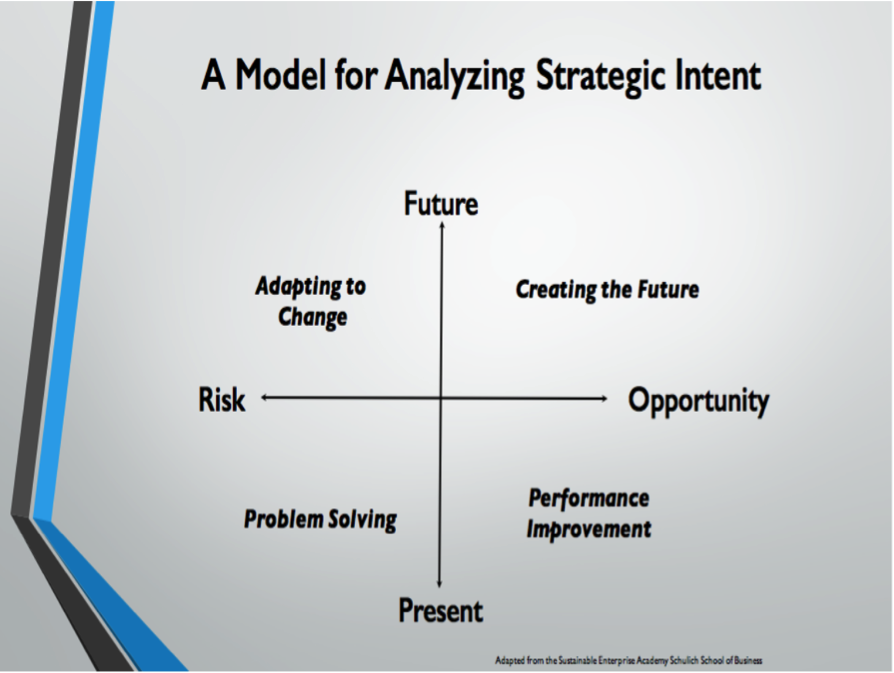
EFL design team member Pong Leung recently interviewed Gord Lambert, an EFL Advisory Council member, to get his take on approaches to Energy Future Lab innovation and collaboration.
You need to critically test for whether the pace and scale at which work is getting done is appropriate to the challenges that you’re trying to take on. Nowadays, it’s a key success factor: can you accelerate progress? On issues like climate change, we have to accelerate progress tremendously.
– Gord Lambert
Pong: You talk about the importance of setting up aspirational goals to help drive innovation. Do you feel that the EFL Vision and Innovation Pathways are aspirational enough to spark bold innovative thinking?
Gord: The process of how you define aspirational goals is almost just as important as the goals themselves. One way to describe the process is that you want creative tension. It needs to make you uncomfortable enough that it engages your creativity, and that you start to get people energized by the challenge of it. But if it’s a bridge too far, if it’s just not plausible, or not even realistic, then you get emotional tension.
Pong: The 11 innovation pathways of the Energy Futures Lab are articulated to allow Alberta to thrive in a low carbon future. Looking at those 11 pathways, do you feel that we’re placing enough efforts on the different quadrants of the two-by-two matrix (see diagram below) Are we innovating sufficiently in those different areas in the context of energy transition?

A Model for Analyzing Strategic Intent
Gord: I’m assuming that in each pathway has very specific action items, or initiatives, or projects. It’s that level of detail that allows you to do a portfolio analysis.
You take every element of resource allocation and action within the 11 areas, and map them into those quadrants. When I use the term action, or project, or initiative, it’s the unit of work that’s going to require resources to be allocated towards it.
What you’re doing in mapping them against those quadrants is you’re testing relative resource allocation, both at an individual initiative scale, action scale, but also an aggregate. The sum total of all the actions against all the 11 pathways show us having a big cluster in one quadrant over another. That type of size-up is useful.
Probably the quick wins area might be one that could be a little skinny. I use the term quick wins for those below the line in the bottom two quadrants. It’s things that you could chalk up as success stories.
Pong: Yeah, right away.
Gord: Right away to get momentum, get enthusiasm, and get folks to see that progress is possible. On energy transition, it’s a huge dilemma as to how you balance that long term and the short term. It’s a long term journey by its nature. Performance goals are a good way to architect in some progress or some quick wins. Milestones, that term in and of itself, can be very useful in innovation projects.
Pong: That’s interesting. One of the things that we haven’t focussed on in our working groups are, as you said, milestones, and relatively near-term performance targets.
Gord: Yeah, it’s very powerful. You want to create urgency to succeed, but it’s also, in the innovation world, it’s quick to fail as well. The creation of milestones works both ways. You don’t want to be putting lots of effort towards an idea that just isn’t getting lift off. It’s just you’ve got to chalk it up as a learning and move on.
Pong: The next question is also about the two-by-two matrix (see diagram above). It’s about helping people think in the above two quadrants, in addition to the bottom two. The question is, what advice do you have for the EFL Fellows to help focus more time and energy on the top two quadrants, in particular in economically challenging times?
Gord: Great question. It’s almost like a Maslow’s hierarchy of needs – states where your near term survival, food and shelter, is chart one, and then how do you imagine aspiring to go beyond that at $40 a barrel, or electricity prices that are two cents a kilowatt hour. It is very challenging.
I think but on the flip side you have the burning platform to innovate dramatically and in absolutely new ways.
A question on strategy often is, “Do you do the same things that you’ve always done but do them incrementally better, or do the same things the same way with more enthusiasm?” That is the hunker down philosophy. Or, do you have to create a new game. That latter question automatically puts you into the top two quadrants.
The other word I’ll introduce that helps take conversations above the line, is the notion of resilience. It’s whether change represents risk to you or opportunity. In reality, resilience is the order of the day. You need more choices, you need more options often. You need more ideas. Introducing the notion of resilience to capture both those upper two quadrants is a powerful word.
Pong: As many of our Fellows are also changemakers in their organizations, what advice do you have for Fellows to introduce the two-by-two matrix to their own organizations to spark these strategic conversations? Where would they start? How would they go about that?
Gord: By bringing it into a conversational model, and just using it, the power of it’s going to become self evident. I can guarantee that with a little bit of use, especially in circumstances where there’s tough conversations, or conversations where there’s lack of alignment, that the use of that two-by-two will bring structure to that conversation that adds value hugely.
Pong: The next question is shifting gears a little bit to the peloton metaphor. What advice do you have for the EFL Fellows to help develop a collaborative peloton mindset in themselves and their organizations, rather than a solely competitive mindset?
Gord: You want models where you can easily create coalitions of the willing. You guys are doing this within the Lab. To make the peloton metaphor work, you have to have this concept of equitable contribution that’s understood as a condition of engagement.
Pong: Anything more in terms of setting up a collaborative peloton mindset or design?
Gord: Just to emphasize the notion of acceleration is important. You need to critically test for whether the pace and scale at which work is getting done is appropriate to the challenges that you’re trying to take on. Nowadays, it’s a key success factor: can you accelerate progress? On issues like climate change, we have to accelerate progress tremendously.
Pong: What other advice do you have for the Energy Futures Lab and the Fellowship to enable collaboration towards a low carbon future?
Gord: I think you guys are doing a lot of the right things, so I can’t point something out that says this is a big miss. I want to emphasize, that clarity of outcomes, either in landing that in the form of goals, milestones, or vision statements, is what causes alignment of effort to occur. People get activity based. They’re busy, lots of things going on, but it’s superficial. It’s cooperation not collaboration, because they’ve never really defined what is success for themselves.
Pong: Great. Thank you Gord. We really appreciate your time and your mentorship on our Energy Futures Lab Advisory Committee.
Gord: Onwards. You guys are doing important work.
Gord Lambert retired from Suncor Energy on January 1, 2015. He is currently the Suncor Sustainability Executive in Residence at the Ivey School of Business, and has established GRL Collaboration for Sustainability as a consulting practice. He is a frequent speaker on energy, the environment and innovation and recently was a speaker on Innovation and Collaboration at the World Economic Forum in Tianjin China.

Pong Leung is a Principal of Travesia Partners and a Senior Associate with The Natural Step Canada. He is a member of the Energy Futures Lab Design Team.



